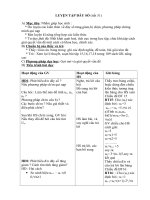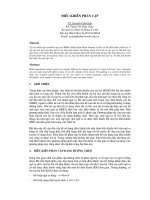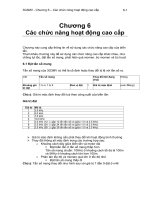Tài liệu Pricing communication networks P6 pptx
Bạn đang xem bản rút gọn của tài liệu. Xem và tải ngay bản đầy đủ của tài liệu tại đây (193.36 KB, 20 trang )
6
Competition Models
Chapter 6 introduces three models of market competition. Their consequences for pricing
are discussed in the Sections 6.2–6.4. In Section 6.1 we define three models for a market:
monopoly, perfect competition and oligopoly. Section 6.2 looks at the strategies that are
available to a monopoly supplier who has prices completely under his control. Section 6.3
describes what happens when prices are out of the supplier’s control and effectively
determined by ‘the invisible hand’ of perfect competition. Section 6.4, considers the middle
case, called oligopoly, in which there is no dominate supplier, but the competing suppliers
are few and their actions can affect prices. Within this section, we present a brief tutorial on
some models in game theory that are relevant to pricing problems. Section 6.5 concludes
with an analysis of a model in which a combination of social welfare and supplier profit is
to be maximized.
6.1 Types of competition
The market in which suppliers and customers interact can be extraordinarily complex.
Each participant seeks to maximize his own surplus. Different actions, information and
market power are available to the different participants. One imagines that a large number
of complex games can take place as they compete for profit and consumer surplus.
The following sections are concerned with three basic models of market structure and
competition: monopoly, perfect competition and oligopoly.
In a monopoly there is a single supplier who controls the amount of goods produced.
In practice, markets with a single supplier tend to arise when the goods have a production
function that exhibits the properties of a natural monopoly. A market is said to be a natural
monopoly if a single supplier can always supply the aggregate output of several smaller
suppliers at less than the total of their costs. This is due both to production economies of
scale (the average cost of production decreases with the quantity of a good produced) and
economies of scope (the average cost of production decreases with the number of different
goods produced). Mathematically, if all suppliers share a common cost function, c,this
implies c.x C y/ Ä c.x/ C c.y/, for all vector quantities of services x and y. We say that
c.Ð/ is a subadditive function. This is frequently the case when producing digital goods,
where there is some fixed initial development cost and nearly zero cost to reproduce and
distribute through the Internet.
In such circumstances, a larger supplier can set prices below those of smaller competitors
and so capture the entire market for himself. Once the market is his alone then his problem is
Pricing Communication Networks: Economics, Technology and Modelling.
Costas Courcoubetis and Richard Weber
Copyright
2003 John Wiley & Sons, Ltd.
ISBN: 0-470-85130-9
142 COMPETITION MODELS
essentially one of profit maximization. In Section 6.2 we show that a monopolist maximizes
his profit (surplus) by taking account of the customers’ price elasticities. He can benefit by
discriminating amongst customers with different price elasticities or preferences for different
services. His monopoly position allows him to maximize his surplus while reducing the
surplus of the consumers. If he can discriminate perfectly between customers, then he can
make a take-it-or-leave it offer to each customer, thereby maximizing social welfare, but
keeping all of its value for himself. If he can only imperfectly discriminate, then the social
welfare will be less than maximal. Intuitively, the monopolist keeps prices higher than
socially optimal, and reduces demand while increasing his own profit.
Monopoly is not necessarily a bad thing. Society as a whole can benefit from the large
production economies of scale that a single firm can achieve. Incompatibilities amongst
standards, and the differing technologies with which disparate suppliers might provide a
service, can reduce that service’s value to customers. This problem is eliminated when a
monopolist sets a single standard. This is the main reason that governments often support
monopolies in sectors of the economy such as telecommunications and electric power
generation. The government regulates the monopoly’s prices, allowing it to recover costs
and make a reasonable profit. Prices are kept close to marginal cost and social welfare is
almost maximized. However, there is the danger that such a ‘benevolent’ monopoly does
not have much incentive to innovate.
A price reduction of a few percent may be insignificant compared with the increase of
social value that can be obtained by the introduction of completely new and life-changing
services. This is especially so in the field of communications services. A innovation is much
more likely to occur in the context of a competitive market.
A second competition model is perfect competition. The idea is that there are many
suppliers and consumers in the market, every such participant in the market is small and
so no individual consumer or supplier can dictate prices. All participants are price takers.
Consumers solve a problem of maximizing net surplus, by choice of the amounts they buy.
Suppliers solve a problem of maximizing profit, by choice of the amounts they supply.
Prices naturally gravitate towards a point where demand equals supply. The key result in
Section 6.3 is that at this point the social surplus is maximized, just as it would be if there
were a regulator and prices were set equal to marginal cost. Thus, perfect competition is
an ‘invisible hand’ that produces economic efficiency. However, perfect competition is not
always easy to achieve. As we have noted there can be circumstances in which a regulated
monopoly is preferable.
In practice, many markets consist of only a few suppliers. Oligopoly is the name
given to such a market. As we see in Section 6.4 there are a number of games that
one can use to model such circumstances. The key results of this section are that the
resulting prices are sensitive to the particular game formulation, and hence depend upon
modelling assumptions. In a practical sense, prices in an oligopoly lie between two
extremes: these imposed by a monopolist and those obtained in a perfectly competitive
market. The greater the number of producers and consumers, the greater will be the
degree of competition and hence the closer prices will be to those that arise under
perfect competition.
We have mentioned that if supply to a market has large production economies of scale,
then a single supplier is likely to dominate eventually. This market organization of ‘winner-
takes-all’ is all the more likely if there are network externality effects, i.e. if there are
economies of scale in demand. The monopolist will tend to grow, and will take advantages
of economies of scope to offer more and more services.
MONOPOLY 143
6.2 Monopoly
A monopoly supplier has the problem of profit maximization. Since he is the only supplier
of the given goods, he is free to choose prices. In general, such (unit) prices may be different
depending on the amount sold to a customer, and may also depend on the identity of the
customer. Such a flexibility in defining prices may not be available in all market situations.
For instance, at a retail petrol station, the price per litre is the same for all customers and
independent of the quantity they purchase. In contrast, a service provider can personalize
the price of a digital good, or of a communications service, by taking account of any given
customer’s previous history or special needs to create a version of the service that he alone
may use. Sometimes quantity discounts can be offered. As we see below, the more control
that a firm has to discriminate and price according to the identity of the customer or the
quantity he purchases, the more profit it can make. Before investigating three types of price
discrimination, we start with the simplest case, in which the monopolist is allowed to use
only linear prices (i.e. the same for all units) uniform across customers.
6.2.1 Profit Maximization
As in Chapter 5, let x
j
. p/ denote the demand for service j when the price vector for a
set of services is p. A monopoly supplier whose goal is profit maximization will choose to
post prices that solve the problem
maximize
p
"
X
j
p
j
x
j
. p/ c.x/
#
The first-order stationarity condition with respect to p
i
is
x
i
C
X
j
p
j
@x
j
@p
i
X
j
@c
@x
j
@x
j
@p
i
D 0 (6.1)
If services are independent, so that ž
ij
D 0fori 6D j, we have, as in (5.14), taking D 1,
p
i
Â
1 C
1
ž
i
Ã
D
@c
@x
i
One can check that this is equivalent to saying that marginal revenue should equal marginal
cost. This condition is intuitive, since if marginal revenue were greater (or less) than
marginal cost, then the monopolist could increase his profit by adjusting the price so that the
demand increased (or decreased). Recall that marginal cost prices maximize social welfare.
Since ž
i
< 0 the monopolist sets a price for service i that is greater than his marginal cost
@c.x/=@ x
i
. At such prices the quantities demanded will be less than are socially optimal
and this will result in a loss of social welfare.
Observe that the marginal revenue line lies below the marginal utility line (the demand
curve). This is illustrated in Figure 6.1, where also we see that social welfare loss occurs
under profit maximization.
If services are not independent then we have, as in (5.15),
X
j
p
j
@c
@x
j
p
j
ž
ij
D1 ; for all i
As already remarked in Section 5.5.1, if some services are complements then it is possible
that some of them sold at less than marginal cost.
144 COMPETITION MODELS
marginal revenue
welfare loss
p
m
x
m
x
demand
$
marginal cost
x
MC
Figure 6.1 A profit maximizing monopolist will set his price so that marginal revenue equals
marginal cost. This means setting a price higher than marginal cost. This creates a social welfare
loss, shown as the area of the shaded triangle.
6.2.2 Price Discrimination
A supplier is said to engage in price discrimination when he sells different units of the same
service at different prices, or when prices are not the same for all customers. This enables
him to obtain a greater profit than he can by using the same linear price for all customers.
Price discrimination may be based on customer class (e.g. discounts for senior citizens),
or on some difference in what is provided (e.g. quantity discounts). Clearly, some special
conditions should hold in the market to prevent those customers to whom the supplier sells
at a low unit price from buying the good and then reselling it to those customers to whom
he is selling at a high unit price.
We can identify three types of price discrimination. With first degree price discrimination
(also called personalized pricing), the supplier charges each user a different price for each
unit of the service and obtains the maximum profit that it would be possible for him to
extract. The consumers of his services are forced to pay right up to the level at which their
net benefits are zero. This is what happens in Figure 6.2.
The monopolist effectively makes a ‘take it or leave it’ offer of the form ‘you can have
quantity x for a charge of ¼’. The customer decides to accept the offer if his net benefit
is positive, i.e. if u.x/ ¼ ½ 0, and rejects the offer otherwise. Hence, given the fact that
the monopolist can tailor his offer to each customer separately, he finds vectors x;¼which
no. units sold
$
3
1
profit = 3
1234
$
3
1
profit = 4
1234
$
3
1
profit = 6
1234
Figure 6.2 A monopolist can increase his profit by price discrimination. Suppose customer A
values the service at $3, but customers B, C and D value it only at $1. There is zero production
cost.Ifhesetstheprice p D $3, then only one unit of the good is (just) sold to customer A for $3.
If he sets a uniform price of p D $1, then four units are sold, one to each customer, generating $4.
If the seller charges different prices to different customers, then he should charge $3 to customer A,
and $1 to customers B, C and D, giving him a total profit of $6. This exceeds $4, which is the
maximum profit he could obtain with uniform pricing.
MONOPOLY 145
solve the problem
maximize
x;¼
"
X
i
¼
i
c.x/
#
subject to u
i
.x
i
/ ½ ¼
i
for all i (6.2)
At the optimum @c.x/=@x
i
D u
0
i
.x
i
/, and hence social surplus is maximized. However,
since the consumer surplus at the optimum is zero, the whole of the social surplus goes to
the producer. This discussion is summarized in Figure 6.3.
One way a seller can personalize price is by approaching customers with special
offers that are tailored to the customers’ profiles. Present Internet technology aids such
personalization by making it easy to track and record customers’ habits and preferences.
Of course, it is not always possible to know a customer’s exact utility function. Learning
it may require the seller to make some special effort (adding cost). Such ‘informational’
cost is not included in the simple models of price discrimination that we consider here.
In second degree price discrimination, the monopolist is not allowed to tailor his offer
to each customer separately. Instead, he posts a set of offers and then each customer can
choose the offer he likes best. Prices are nonlinear, being defined for different quantities.
A supplier who offers ‘quantity discounts’ is employing this type of price discrimination.
Of course his profit is clearly less than he can obtain with first degree price discrimination.
Second degree price discrimination can be realized as follows. The charge for quantity x
is set at ¼.x / (where x might range within a finite set of value) and customers self-select
by maximizing u
i
.x
i
/ ¼.x
i
/, i D 1;:::;n.
Consider the case that is illustrated in Figure 6.4(a). Here customer 1 has high demand
and customer 2 has low demand. Assume for simplicity that production cost is zero. If the
monopolist could impose first degree price discrimination, he would maximize his revenue
by offering customer 1 the deal ‘x
1
for A C B C C’, and offering customer 2 ‘x
2
for
A’. However, under second degree price discrimination, both offers are available to the
customers and each customer is free to choose the offer he prefers. The complication is
that although the low demand customer will prefer the offer ‘x
2
for A’, as the other offer is
infeasible for him, the high demand customer has an incentive to switch to ‘x
2
for A’, since
he makes a net benefit of B (whereas accepting ‘x
1
for A C B C C’ makes his net benefit
zero). To maintain an incentive for the high demand customer to choose a high quantity,
the monopolist must make a discount of B and offer him x
1
for A C C. It turns out that the
x
$
offer ‘x for A’
x(p)
marginal cost
A
Figure 6.3 In first degree price discrimination the monopolist extracts the maximum profit from
each customer, by making each a take-it-or-leave-it offer of the form ‘you may have x for A
dollars’. He does this by choosing x such that u
0
.x / D c
0
.x / and then setting A D u.x/.Inthe
example of this figure the demand function is linear and marginal cost is constant. Here A is the
area of the shaded region under the demand function x. p/.
146 COMPETITION MODELS
x
2
for A
x
1
for A + C + D
$
x
2
x
1
x
A
B′
C
D
(b)(a)
x
2
for A
x
1
for A + B + C
$
MC = 0
x
2
x
1
x
A
B
C
x
1
(p)
x
2
(p)
Figure 6.4 Second degree price discrimination for a low and a high demand customer. For
simplicity the marginal cost of production is zero. Given the offers in (a), customer 1 (the ‘high’
demand customer) will choose the offer intended for customer 2 (the ‘low’ demand customer),
unless he is offered ‘x
1
for A C C dollars’. The net benefit of customer 1 is the shaded area. This
motivates the producer to decrease x
2
and make an offer as in (b), where B
0
C D < B.The
optimum value of x
2
achieves the minimum of B
0
C D, which is the amount by which the
producer’s revenue is less than it would be under first degree price discrimination.
monopolist can do better by reducing the amount that is sold to the low demand customer.
This is depicted in Figure 6.4(b), where the offers are x
1
for A C D C C,andx
2
for A.
There is less profit from the low demand customer, but a lower discount is offered to the
high demand customer, i.e. in total the monopolist does better because B
0
C D < B.The
optimum value of x
2
achieves the minimum of B
0
C D, which is the amount by which the
producer’s revenue is less than it would be under first degree price discrimination.
More generally, the monopolist offers two or more of versions of the service, each of
which is priced differently, and then lets each customer choose the version he prefers. For
this reason second degree price discrimination is also called versioning. As illustrated above,
one could define the versions as different discrete quantities of the service, each of which is
sold at a different price per unit. Some general properties hold when the supplier’s creates
his versions optimally in this way: (i) the highest demand customer chooses the version of
lowest price per unit; (ii) the lowest demand customer has all his surplus extracted by the
monopolist; and (iii) higher demand customers receive an informational rent.Thatis,they
benefit from having information that the monopolist does not (namely, information about
their own demand function).
Quantity is not the only way in which information goods and communications services
can be versioned. They can be also be versioned by quality. Interestingly, in order to create
different qualities, a provider might deliberately degrade a product. He might add extra
software to disable some features, or add delays and information loss to a communications
service that already works well. Note that the poorer quality version may actually be the
more costly to produce. Another trick is to introduce various versions of the products at
different times. Versioning allows for an approximation to personalized prices. A version
of the good that is adequate for the needs of one customer group, can be priced at what
that group will pay. Other customer groups may be discouraged from using this version
by offering other versions, whose specific features and relative pricing make them more
attractive. Communication services can be price discriminated by the time of day, duration,
location, and distance.
In general, if there is a continuum of customer types with growing demand functions
the solution to the revenue maximization problem is a nonlinear tariff r.x/.Suchtariffs
can be smooth functions with r .0/ D 0, where the marginal price p D r
0
.x/ depends on
MONOPOLY 147
the amount x that the customer purchases. In many cases, r.x/ is a concave function and
satisfies the property that the greatest quantity sold in the market has a marginal price equal
to marginal cost. Observe that this holds in the two customer example above. The largest
customer consumes at a level at which his marginal utility is equal to marginal cost, which
is zero in this case.
Theideaofthird degree price discrimination is market segmentation. By market segment
we mean a class of customers. Customers in the same class pay the same price, but
customers is different classes are charged differently. This is perhaps the most common form
of price discrimination. For example, students, senior citizens and business professionals
have different price sensitivities when it comes to purchasing the latest version of a financial
software package. The idea is not to scare away the students, who are highly price sensitive,
by the high prices that one can charge to the business customers, who are price insensitive.
Hence, one could use different prices for different customer groups (the market segments).
Of course, the seller of the services must have a way to differentiate customers that belong
to different groups (for example, by requiring sight of a student id card). This explains why
third degree price discrimination is also called group pricing.
Suppose that customers in class i have a demand function of x
i
. p/ for some service.
The monopolist seeks to maximize
max
fx
i
.Ð/g
n
X
iD1
p
i
x
i
. p
i
/ c
n
X
iD1
x
i
. p
i
/
!
Assuming, for simplicity, that the market segments corresponding to the different classes
are completely separated, the first order conditions are
p
i
.x
i
/ C p
0
i
.x
i
/x
i
D c
0
n
X
iD1
x
i
!
If ž
i
is the demand elasticity in market i, then these conditions can be written as
p
i
.x
i
/
Â
1 C
1
ž
i
Ã
D c
0
n
X
iD1
x
i
!
(6.3)
These results are intuitive. The monopolist will charge the lowest price to the market
segment that has the greatest demand elasticity. In Figure 6.5 there are two customers
classes, with demand functions x
1
. p/ D 6 3 p and x
2
. p/ D 2 2 p. The solution to (6.3)
with the right hand side equal to 1=2is p
1
D 5=4and p
2
D 3=4, with x
1
D 9=2and
x
2
D 1=4. At these points, ž
1
D5=3, ž
2
D3.
The market segment that is most price inelastic will be charged the highest price. Similar
results hold when the markets are not independent and prices influence demand across
markets.
A simple but clever way to implement group pricing is through discount coupons. The
service is offered at a discount price to customers with coupons. It is time consuming to
collect coupons. One class of customers is prepared to put in the time and another is not.
The customers are effectively divided into two groups by their price elasticity. Those with
a greater price elasticity will collect coupons and end up paying a lower price.
It is interesting to ask whether or not the overall economy benefits from third degree price
discrimination. The answer is that it can go either way. Price discrimination can only take
place if different consumers have unequal marginal utilities at their levels of consumption,
148 COMPETITION MODELS
$
x
2
x
1
x
p
2
p
1
x
2
(p
2
)
x
1
(p
1
)
Figure 6.5 In third degree price discrimination customers in different classes are offered different
prices. By (6.3) the monopolist maximizes his profits by charging more to customer classes with
smaller demand elasticity, which in this example is customer class 1.
which is (generally) bad for welfare. But it can increase consumption, which is good for
welfare. A necessary condition for there to be an increase in welfare is that there should
be an increase in consumption. This happens in the example of Figure 6.5. There are two
markets and one is much smaller than the other. If third degree price discrimination is not
allowed, then the monopolist will charge a high price and this will discourage participation
from the small market. However, if third degree price discrimination is allowed, he can
set the same price for the high demand market, and set a low price for the low demand
market, so that this market now participates. If his production cost is zero, the monopolist
increases his surplus and users in the second market obtain a nonzero surplus; hence the
overall surplus is increased.
6.2.3 Bundling
We say that there is bundling when a number of different products are offered as a single
package and at a price that differs from the sum of the prices of the individual products.
Bundling is a form of versioning.
Consider two products, A and B, for which two customers C
1
and C
2
have different
willingness to pay. Suppose that C
1
is prepared to pay $100 and $150 for A and B,
respectively, and C
2
is prepared to pay $150 and $100 for A and B, respectively. If no
personalized pricing can be exercised, then the seller maximizes his revenue by setting
prices of $100 for each of the products, resulting in a total revenue of $400. Suppose now
that he offers a new product that consists of the bundle of products A and B for a price of
$250. Now both customers will buy the bundle, making the revenue $500. Essentially, the
bundle offers the second product at a smaller incremental price than its individual price.
Note that $500 is also the maximum amount the seller could obtain by setting different
prices for each customer, i.e. by perfect price discrimination.
It is interesting that bundling reduces the dispersion in customers’ willingness to pay for
the bundle of the goods. For each of the goods in our example, there is a dispersion of $50
in the customers’ willingness to pay. This means that overall lower prices are needed to
sell the goods to both customers. Now there is no dispersion in the customers’ willingness
to pay for the bundle. Both are willing to pay the same high price. This is the advantage
of creating the new product. In general, optimal bundles are compositions of goods that
reduce the dispersion in customers’ willingness to pay.
Bundling is common in the service offerings of communication providers. For instance, it
is usual for an ISP to charge its subscribers a monthly flat fee that includes an email account,









